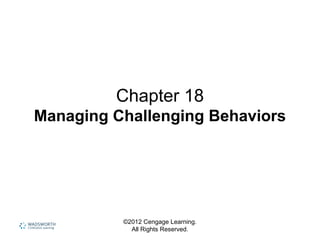More Related Content
Similar to Chapter18 allen7e (20)
Chapter18 allen7e
- 2. ©2012 Cengage Learning.
All Rights Reserved.
Developmentally Normal Deviations
• Most children exhibit mood swings.
• Most children have had at least one
tantrum.
• Children have off days.
• Normal deviations become fixed patterns
when they get the adult attention.
- 3. ©2012 Cengage Learning.
All Rights Reserved.
Developmentally Normal Deviations
(continued)
• Temperament
– Goodness of fit.
– Caregivers and children need to fit each
other.
– Active children need caregivers who respect
and appreciate the child’s need to move.
– Quiet children need a caregiver who
understands their need for more one-on-one
time.
- 4. ©2012 Cengage Learning.
All Rights Reserved.
Developmentally Normal Deviations
(continued)
• When is a behavior a problem?
– Occasional outbursts are not a concern.
– Behaviors that increase in intensity need a
second look.
– How much is too much of a behavior?
– Observation will be the key.
- 5. ©2012 Cengage Learning.
All Rights Reserved.
Developmentally Normal Deviations
(continued)
• Tiered Framework for Intervention
– Build positive relationships
– Preventative classroom interventions
– Social emotional teaching strategies
– Planning intensive individualized interventions
- 6. ©2012 Cengage Learning.
All Rights Reserved.
Developmentally Normal Deviations
(continued)
• Designing interventions
– Positive behavior support
• Identify the behavior.
• Identify the settings in which it occurs.
• Design interventions with which all team members
are comfortable.
- 7. ©2012 Cengage Learning.
All Rights Reserved.
Developmentally Normal Deviations
(continued)
• Five features critical to identifying
challenging behaviors:
– Comprehensive
– Individualized
– Positive programming
– Multidisciplinary
– Data-based
- 8. ©2012 Cengage Learning.
All Rights Reserved.
Developmentally Normal Deviations
(continued)
• A functional approach to managing
problem behaviors
– Examine the environment.
– Examine your own behaviors.
– Use a functional behavior assessment.
- 9. ©2012 Cengage Learning.
All Rights Reserved.
Developmentally Normal Deviations
(continued)
• Steps to a functional behavior
assessment:
– Identify the problem situation.
– Assess the child and the environment.
– Specify an objective for the intervention.
– Assess the function of the behavior.
- 10. ©2012 Cengage Learning.
All Rights Reserved.
Developmentally Normal Deviations
(continued)
– Identify a replacement behavior.
– Plan the intervention.
– Implement the plan and ensure that it is
carried out as planned.
– Monitor the child’s progress and continue to
monitor implementation.
- 11. ©2012 Cengage Learning.
All Rights Reserved.
Data Collection and Monitoring
Progress
• Types of data collection
– Frequency—number of times a behavior
occurs
– Duration—how long each episode occurs
– Interval—breaking the day up into intervals
and evaluating when the behavior occurs
- 12. ©2012 Cengage Learning.
All Rights Reserved.
Data Collection and Monitoring
Progress (continued)
• Collecting data
– Record a baseline—observe the child three to
five days before intervention
– Frequency methods
– Duration methods
– Interval methods
- 13. ©2012 Cengage Learning.
All Rights Reserved.
Data Collection and Monitoring
Progress (continued)
• Aggressiveness
– Conflict—seeing what triggers the behavior
– Managing aggressiveness—watching for the
triggers, eliminating them, teaching
appropriate responses to emotions
- 14. ©2012 Cengage Learning.
All Rights Reserved.
Data Collection and Monitoring
Progress (continued)
• Disruptive and destructive behaviors
– Need for attention
– Mastering routines
– Redirection
– Time-out
- 15. ©2012 Cengage Learning.
All Rights Reserved.
Data Collection and Monitoring
Progress (continued)
• Noncompliance
– Refusing to do what an adult asks
– Prevention strategies
– Preventive discipline
- 16. ©2012 Cengage Learning.
All Rights Reserved.
Data Collection and Monitoring
Progress (continued)
– Other strategies
• Give advanced warning.
• Reduce overload.
• Make requests and give directions clearly and
briefly.
• Provide choice.
• Beware of choices that are not choices.
• Focus the child’s attention.
• Allow time to comply.
• Practice consistency and firmness.
• Make sound judgments.
- 17. ©2012 Cengage Learning.
All Rights Reserved.
Data Collection and Monitoring
Progress (continued)
• Temper tantrums
– Tantrums are a child’s try at control over
adults.
– Children learn that they need to tantrum
longer to break down the adults.
– Management of tantrums
• Consistency
• Safety
• Identification of underlying causes
- 18. ©2012 Cengage Learning.
All Rights Reserved.
Data Collection and Monitoring
Progress (continued)
• Separation problems
– Children experience separation problems as a
developmental milestone.
– Consistency in routine and caregivers is
important.
– It will pass, but children need to know that
they can trust what is in their environment.
- 19. ©2012 Cengage Learning.
All Rights Reserved.
Data Collection and Monitoring
Progress (continued)
• Overdependence
– Children are clingy to a teacher or parent.
– Teacher needs to walk a fine line:
• Too little attention, child feels rejected.
• Too much attention, child’s behavior increases.
- 20. ©2012 Cengage Learning.
All Rights Reserved.
Data Collection and Monitoring
Progress (continued)
• Withdrawal
– Withdrawn children do not draw the teacher’s
attention.
– They can retreat even further from social
situations.
- 21. ©2012 Cengage Learning.
All Rights Reserved.
Data Collection and Monitoring
Progress (continued)
– Questions to ask
• Does the child engage in activities?
• Do the materials interest the child?
• Does the child spend time watching other children?
• Is the child likely to leave an activity if certain
children approach?
• Does the child play close to some children?
- 22. ©2012 Cengage Learning.
All Rights Reserved.
Data Collection and Monitoring
Progress (continued)
• Inability to share
– To aid children in learning this skill:
• Provide multiples of materials.
• Interest centers should be attractive.
• Encourage a gamelike atmosphere.
